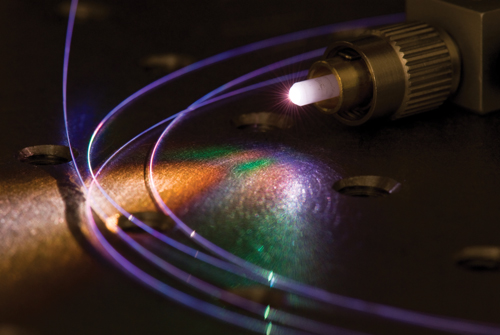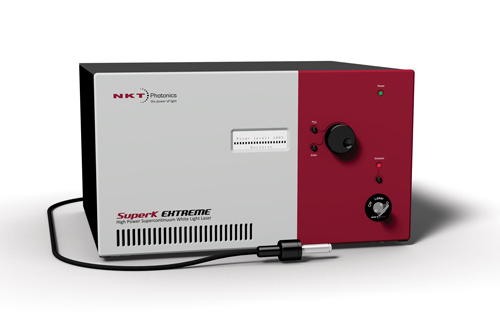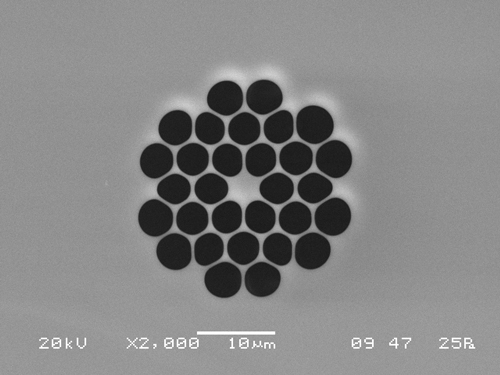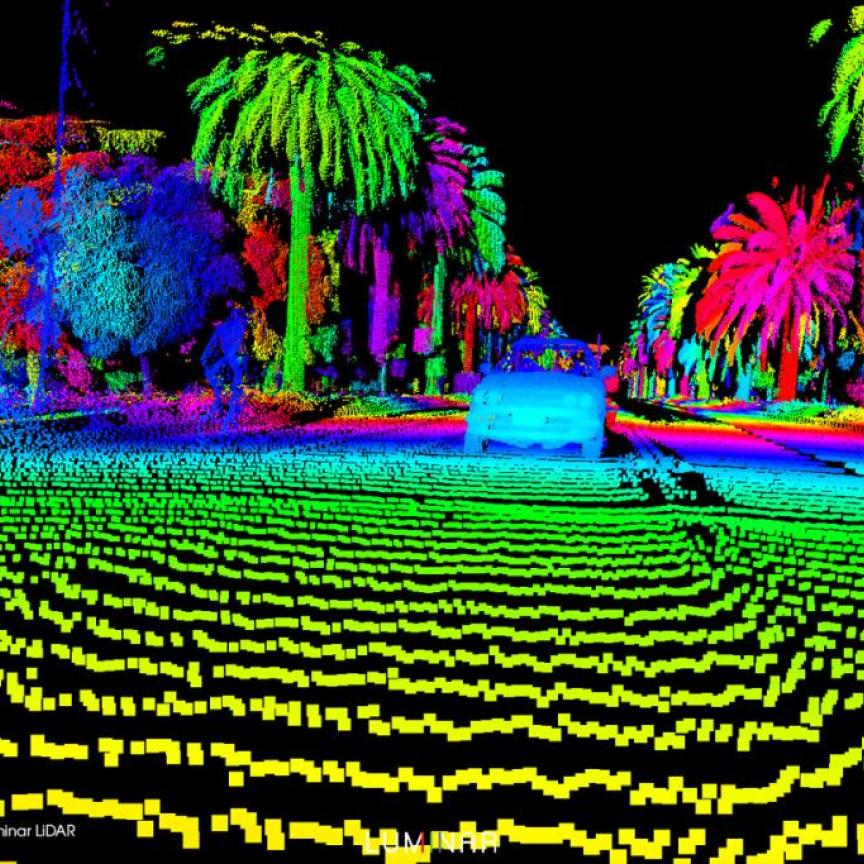Supercontinuum light sources emit the broad wavelengths of a lamp, while providing the brightness and long lifetimes of a laser. They offer the best of both worlds and, as a result, a range of applications are becoming apparent.
Dr James Stone, research associate at the University of Bath, explained: ‘It’s been repeated many times, but the supercontinuum is such a versatile tool for any application where multiple wavelengths are needed. The combination of broad bandwidth with high brightness in a single spatial mode, meaning all the light can easily be manipulated, is the perfect starting point for so many applications in industry and research.’
A supercontinuum source essentially has two components: a laser pump source and a photonic crystal fibre. The laser emits short, single wavelength, high energy pulses that are launched into the photonic crystal fibre (PCF), which has cladded air holes specifically tailored for supercontinuum generation.
Without the PCF component, the device is essentially a high-power pulsed laser. PCFs provide the nonlinear element in the process. They work by guiding light using an array of air holes running through cladding in order to achieve the index contrast needed for total internal reflection.
Changing the size and separation of the air holes allows the properties of the fibre to be altered in a way simply not achievable in conventional fibres. Dr Stone said: ‘This freedom means the properties of the fibre can be tailored for supercontinuum generation from a laser of a given single wavelength.’
There are several aspects of nonlinear PCFs that need to be controlled to make commercial supercontinuum sources, including mode quality, dispersion profile, attenuation and lifetime. Kim Per Hansen, marketing director at NKT Photonics, said: ‘Other critical components are the mode-locked fibre laser seeders, used for the high power ultrafast systems, and the high power fibre amplifiers.’
Supercontinuum sources are typically used in applications where the alternative would be to use several single-line lasers, LEDs or lamps. However, supercontinuum sources offer several advantages over these conventional methods.
As an alternative to several single-line sources, supercontinuum lasers offer a simpler and more robust system, that is both alignment and maintenance free. Moreover, since the output of a supercontinuum laser is continuous, users can access wavelengths not available in single-line sources, which also means that the laser can sweep through wavelengths or illuminate using advanced spectral profiles matched to the task.

Image of white supercontinuum light emerging from a PCF. The input lights a 1,064nm laser and invisible to the naked eye
When used as a lamp replacement, supercontinuum sources offer a lower cost of ownership and increased up-time compared to a lamp-based system, which typically has to be serviced or replaced many times over the lifetime of a supercontinuum laser. For example, a lamp’s life is of the order of hundreds of hours compared to thousands of hours for a supercontinuum laser. Supercontinuum lasers also require less power and cooling, as they are much more efficient.
Finally, the brightness of supercontinuum lasers is orders of magnitude greater than even the best lamps, as they are essentially single-mode fibre sources. This leads to an increased throughput and the ability to split a single supercontinuum laser and deliver its light to several workstations or tools.
Investigating infrared
Supercontinuum laser sources have only just begun to move into a wider range of commercial applications outside of microscopy. Infrared supercontinuum sources, in particular, are expected to prove useful in applications such as spectroscopy, imaging and lidar.
Researchers at the Toyota Technological Institute are studying supercontinuum generation by pumping with a near-infrared (NIR) pulse to achieve a coherent source. Kenshiro Nagasaka, a PhD student at the Research Centre for Advanced Photon Technology, Toyota Technological Institute, explained: ‘The coherent supercontinuum is important for many applications such as optical coherence tomography, spectroscopy, and metrology because those applications use the interference, and need a high brightness.’
Supercontinuum generation by pumping with an NIR pulse is important to realise the practical applications promised by supercontinuum. ‘In most of the studies in mid-infrared [MIR] supercontinuum generation, researchers have used an MIR pump source, which is not available on the market. We moved on to use the market-available NIR pump source with a high repetition rate,’ noted Nagasaka.
MIR supercontinuum light sources could also be used in the biometric and industrial fields. Nagasaka added: ‘However, in the MIR region, detectors, lens, filters, and gratings are limited. I think we need to develop those things. When those things are available in the market, supercontinuum light sources can develop the biophotonics market.’
Researchers at the Technical University of Denmark (DTU) and Research Nanyang Technological University, Singapore (NTU) have demonstrated MIR supercontinuum generation using highly GeO2 doped fibres, which is an important step, as Ge-doped silica fibres have a lower loss above 2µm compared to conventional silica fibres. Increasing the doping lowers the loss, making this a commercially viable option.
Dr Sidharthan Raghuraman, research fellow at Nanyang Technological University, Singapore, explained: ‘This, together with high nonlinearity, makes it a good candidate for supercontinuum generation. To the best of our knowledge, this is the record power, ultra-broadband, and all-fibre supercontinuum light source based on silica and germania fibre demonstrated to date.’
The experiments achieved an output power of 1.42W for a broad spectrum from 700 to 3,200nm and 6.4W for 800 to 2,700nm from these fibres, while being pumped by a broadband four stage erbium fibre-based master oscillator power amplifier (MOPA). These investigations reveal the potential of germania-doped fibres for mid-infrared supercontinuum generation.
The group is now working towards developing mid-IR laser sources, including supercontinuum sources, using various fibre compositions and designs. ‘In continuation of the work reported in the paper, we are working towards scaling the power and extending the spectrum well beyond 3.5µm,’ Dr. Raghuraman added.
Challenges remain, including the need to increase the pump source power. The stress in the fibre preform also increases with the GeO2 concentration, due to thermal expansion coefficient mismatch, and this results in cracking of the core during the vapour deposition process.
Single specialist
There are several small companies in the supercontinuum field but, particularly since its acquisition of UK-based Fianium, NKT Photonics is by far the largest. Hansen explained the reason why there are not more players in this sector: ‘The two main reasons are that you need to master many different disciplines within high power fibre optics ranging from mode-locked fibre lasers over high power fibre amplifiers to the advanced nonlinear photonic crystal fibres. To succeed in them all, you basically need to be a fibre manufacturer yourself and be able to manufacture photonic crystal fibres, while also having solid knowledge within ultrafast fibre lasers.’
Hansen continued: ‘Very few companies have all those competencies in-house. Most laser manufacturers do not have a fibre background and the few that do, have typically gone for the high power material processing market.
‘Lastly, supercontinuum lasers and photonic crystal fibres are heavily IP protected, so even if you overcome the technical hurdles, it is difficult for new players to enter the market, as much of the fundamental IP needed is owned by NKT Photonics.’

NKT Photonics' SuperK Extreme supercontinuum laser
This sentiment is echoed by researchers working with supercontinuum, who would benefit from an industrial partner. ‘Already companies such as NKT are developing good quality supercontinuum sources that are used widely,’ Dr Raghuraman remarked. ‘For our technology to reach that level, we need collaboration with such companies to come up with the best product that meets customer requirements. The supercontinuum technology goes hand in hand with pump source technology. Advances in high power compact pump sources will facilitate translation of our supercontinuum technology to industrial applications.’
Such collaboration is important for the future of supercontinuum sources, as Dr Stone said: ‘In the short term, the pooling of expertise and combining of technologies is likely to lead to better supercontinuum products. However, the absence of a big competitor could take the emphasis off the need for rapid exploitation of cutting edge innovation.’
Super applications
Supercontinuum sources are now deployed in a range of commercial applications, including the characterisation of optical components in the microelectronics industry, in semiconductor tools and the life sciences sector. Sources typically have a lifetime of several thousand hours and an up-time on par with other industrial lasers. ‘We [NKT] are continuously improving power output, spectral coverage and lifetime of the system as well as including advanced filtering options, often through direct projects and partnerships with the commercial customers,’ Hansen commented. ‘Further commercial market penetration is more a matter of application development and awareness in the industrial sector – the sources are ready.’
Within the research space, improved lifetimes and reduced costs are still needed, Dr Stone noted: ‘A step up to ultra-reliability would almost certainly be needed in demanding commercial applications. A lifetime of 10,000 hours may seem sufficient to a lab user, but this could amount to little over a year of intensive round the clock industrial use.
‘For real widespread use in research the barrier, in my opinion, is cost. A supercontinuum source is almost certainly seen as a significant investment by research groups but really there should be one in every lab as the go-to light source. For this to happen the cost needs to come down,’ he added.

Scanning electron microscope image of a typical PCF used for supercontinuum generation from a 1,064 source
This will depend not on advancements in the PCF technology but instead on improvements to the fibre laser systems, Dr Stone explained: ‘There are always customers who want different wavelengths (IR, UV) or more power. Improvements to current sources will hopefully create ultra-reliable and low-cost sources. Innovations leading to these would put supercontinuum sources into widespread use throughout industry and research. The advancement is unlikely to be in photonic crystal fibre technology and more likely to be due to improvements in fibre laser technology.’
Dr Raghuraman predicted that more mid-IR sources with broader spectrums and power levels will also appear in the market. He added: ‘Fabrication of fibres with lower loss in the mid-IR region remains a crucial challenge. Many approaches are being taken – hopefully some will work out well.’
Nagasaka added: ‘We also need to miniaturise a laser light source. I think we can improve the stability and brightness of the supercontinuum light source by using a small laser system. In order to do that, we need to develop the fibre fabrication and numerical simulations, and need to reveal the nonlinear optical phenomena in more detail.’
The good news is that manufacturers expect prices and instrument sizes to drop, as Hansen said: ‘As the use of supercontinuum lasers in commercial high volume applications increases, we will see sources become smaller and cheaper. At the other end of the spectrum, we will see high output power and the availability of new wavelength ranges such as IR.’
In the future, supercontinuum sources will also be increasingly matched to the applications they are used in, as Hansen added: ‘Sources will also be more specialised as the volume for single applications increases. We will move from do-it-all sources with all features, to sources that are tailored to an application and a customer with just the features and filtering needed for that application.’It seems that both OEMs and researchers are ready to face the challenges of supercontinuum sources, to introduce them into a broader range of industrial settings. With continued collaboration, supercontinuum sources could see widespread success in both the commercial and academic world.


